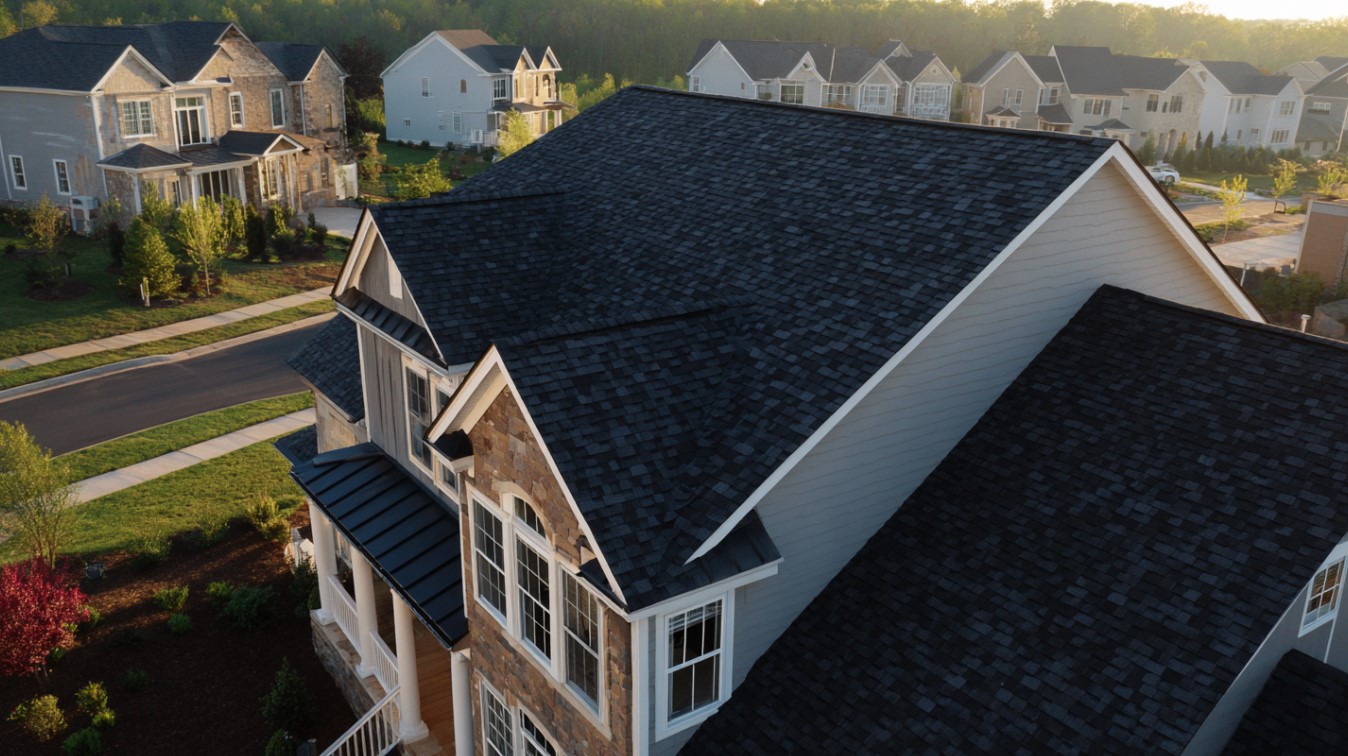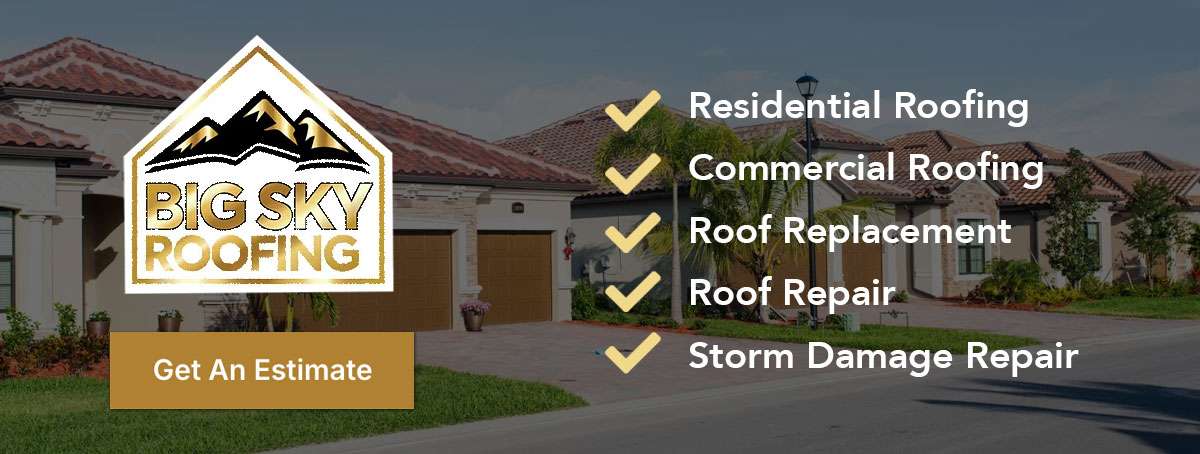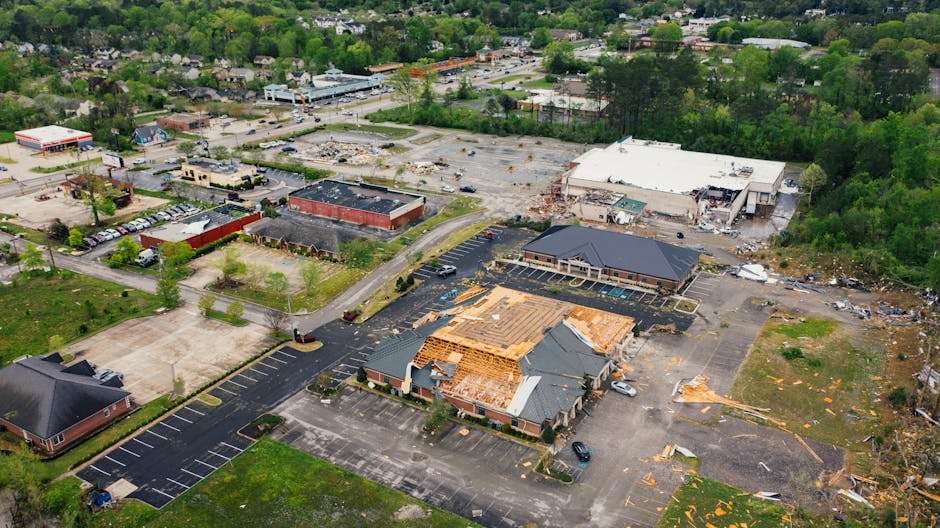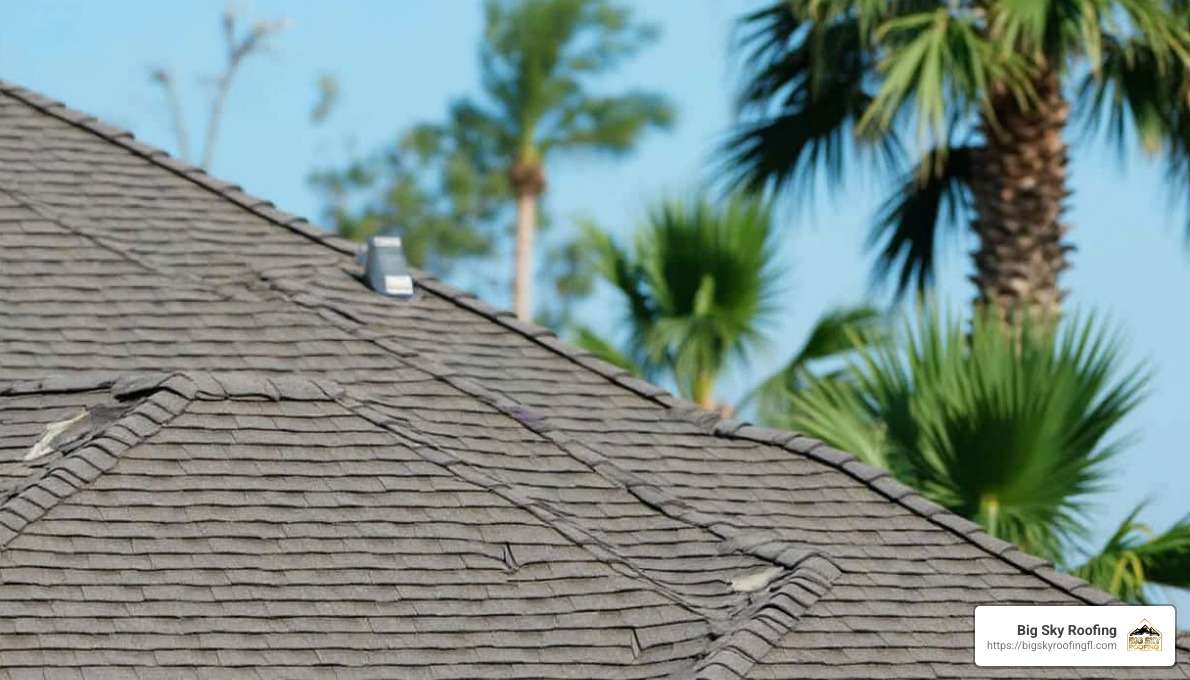Flat vs. Pitched Roofs: Roofing Choices for Modern Houses
•
Written By

Understanding Flat Roof Systems for Contemporary Houses
Understanding flat roof systems is essential for modern homeowners interested in both aesthetic appeal and cost efficiency, especially when factoring in new roof cost Clermont. Flat roofs, characterized by their minimal slope, are becoming increasingly popular in contemporary residential design due to their sleek appearance and modern functionality. These roofs are designed to create a seamless look, integrating clean lines and geometric forms that complement urban and modern architectural styles. Roofing contractors note that flat roofs are primarily used on modern houses where a minimalist, industrial aesthetic is desired.
Defining the Modern Flat Roof Aesthetic Flat roofs provide a distinct look defined by their smooth, horizontal surfaces. They often incorporate elements like parapets, hidden gutters, or integrated solar panels. This minimalist design fosters an open, airy feel and can dramatically enhance a modern home’s curb appeal. The aesthetic is particularly favored in urban environments where clean, unobstructed lines align with contemporary design philosophies. Architectural innovators and contractors alike see the flat roof as a canvas that can easily blend with creative outdoor living spaces and green roof initiatives.
Common Materials Used by Roofing Contractors for Flat Roofs The selection of materials significantly influences the performance and durability of flat roof systems. Roofing contractors typically use bitumen-based membranes, ethylene propylene diene monomer (EPDM) rubber, thermoplastic polyolefin (TPO), and polyvinyl chloride (PVC) membranes. Each material has distinctive properties: bitumen membranes are known for their proven track record and robust waterproofing; EPDM offers excellent cost-effectiveness and longevity; TPO provides energy efficiency due to its reflective properties; PVC is resistant to chemicals and fire. The choice of material also reflects local climate conditions and the homeowner’s budget, ensuring that the roof can withstand local weather extremes from hail and heavy rains to intense sun exposure.
Lifespan Expectations for Flat Roofs on Modern Residences The expected lifespan of a flat roof varies with the chosen material, design, and regular maintenance practices. Roofing professionals estimate that well-installed and regularly maintained flat roofs can last between 20 and 30 years. For instance, PVC roofs, when properly installed with routine periodic inspections, can reach the higher end of that spectrum, while EPDM and TPO options may require more frequent maintenance but still offer durability against the elements. Contractors emphasize that regular inspections, timely repairs, and proper cleaning routines are critical in extending the life of a flat roof, especially in regions with high precipitation or intense solar radiation.
Drainage Solutions Roofing Contractors Implement for Flat Surfaces Drainage is a vital component of flat roof design that cannot be overlooked. Because of the minimal slope, these roofs must incorporate effective drainage systems to prevent water pooling and leakage. Common drainage solutions include internal drains, scuppers, and tapered insulation systems that slope towards drainage points. Roofing companies install internal drains at strategic locations to collect and channel rainwater away from the building, while scuppers provide an exit point near parapets. Additionally, contractors often advise on employing a tapered insulation system that creates a gradual slope without visibly altering the roof’s flat appearance. These interventions ensure that even during heavy downpours, water is efficiently expelled, reducing the risk of structural damage and ensuring the roof’s long-term performance.
Usable Space Opportunities With Flat Roof Designs One of the significant advantages of flat roof systems is the additional usable space they offer. Homeowners can transform a flat roof into an outdoor living area, rooftop garden, or even a solar panel installation site. This multifunctional space allows for greater creativity in urban design, where outdoor space is at a premium. Roofing contractors often collaborate with landscape architects to integrate green roofs, which can provide insulation, reduce energy costs, and promote environmental sustainability. By harnessing this extra space, homeowners not only improve the aesthetic appeal of their properties but also add functional, recreational areas that contribute to overall quality of life.
Exploring Pitched Roof Characteristics for Today’s Homes
Pitched roofs remain a popular choice among homeowners, particularly for those seeking traditional beauty combined with modern functionality. With their angled surfaces, pitched roofs are renowned for their superior water shedding capabilities, which can significantly reduce leakage and maintenance issues compared to flat roofs. In modern residential design, the pitched roof transcends its conventional appearance by incorporating contemporary materials and innovative design elements that cater to both aesthetic considerations and structural benefits.
Defining Pitched Roof Styles and Their Visual Impact Pitched roofs come in a variety of designs, including gabled, hipped, and mansard styles. Each style offers its unique visual impact and practical benefits. Gabled roofs, with their triangular profile, are often associated with classical and suburban architecture, providing a sense of timelessness and robustness. Hipped roofs, which slope on all sides, offer a more balanced aesthetic and superior wind resistance, making them an excellent choice in storm-prone areas. Meanwhile, mansard roofs create a dramatic appearance with steep sides and a relatively flat top, often used in urban settings to maximize attic space. Roofing contractors appreciate these diverse styles because they can tailor designs that not only enhance the visual appeal of a home but also improve functionality by optimizing the amount of usable attic space and ensuring adequate insulation.
Popular Materials Roofing Contractors Suggest for Pitched Roofs The materials typically chosen for pitched roofs are steeped in tradition, yet modern innovations have broadened the range of options available. Asphalt shingles remain the industry standard due to their affordability, ease of installation, and wide range of aesthetic choices from traditional to contemporary looks. However, clay and concrete tiles are increasingly popular for their durability and timeless elegance, especially in warmer climates where their natural cooling properties are advantageous. Metal roofing has also gained traction due to its superior longevity and resistance to extreme weather conditions, including hail and heavy rains. Roofing professionals advise that the accessibility to repairs and the upfront cost of these materials should be carefully considered, ensuring that homeowners select options that align with their climate, architectural design, and budget constraints.
Durability and Weather Resistance of Pitched Roof Structures One of the strongest attributes of pitched roofs is their natural resilience against adverse weather conditions. The angled surface of a pitched roof facilitates the rapid shedding of rain, snow, and even wind-driven debris, which helps prevent moisture pooling and subsequent leakage. This design inherent in pitched roofs enhances structural integrity and minimizes the chances of water intrusion, a factor that is critical in areas where heavy rainfall or snowfall is common. Roofing contractors highlight that the choice of high-quality materials, along with proper installation techniques such as underlayment and flashing, plays a pivotal role in maximizing the durability of pitched roofs. Contractors often refer to studies indicating that properly maintained pitched roofs can exceed 40 years in lifespan, even under challenging environmental conditions.
Attic Space and Ventilation Advantages Noted by Roofing Experts In addition to their weather-resistant benefits, pitched roofs create valuable attic space that can be utilized for extra storage or converted into living areas, thereby increasing the overall square footage of a home. Proper attic ventilation is essential in regulating temperature fluctuations and preventing moisture build-up, which can lead to mold growth and deterioration of roof materials. Roofing contractors commonly recommend installation of ridge vents, soffit vents, and attic fans as effective means to achieve consistent air circulation. These ventilation systems help to balance the temperature within the attic, reducing energy costs while ensuring the longevity of the roofing structure. By providing both extra space and improved energy efficiency, pitched roofs offer a well-rounded solution for modern homeowners seeking to combine practicality with an elevated aesthetic.

Architectural Versatility of Pitched Roofs in Modern Design Pitched roofs offer a level of architectural versatility that is highly prized in both traditional and contemporary designs. Their varied profiles and adaptability to different materials mean that they can be seamlessly integrated into a wide array of aesthetic themes—from classic colonial homes to ultra-modern mansions. This versatility allows homeowners and designers to experiment with unique rooflines, integrating skylights, dormers, and even green roofing elements, thereby creating visually stunning and functionally superior structures. As roofing contractors work hand-in-hand with architects and designers, they bring technical expertise that ensures each pitched roof not only meets structural demands but also elevates the overall integrity and style of the home.
Roofing Contractor Advice on Cost Factors for Flat and Pitched Roofs
Cost is a pivotal factor in determining the most suitable roofing system for modern homes, and roofing contractors emphasize a detailed assessment of both initial and long-term expenditures. Homeowners must consider several variables when selecting between flat and pitched roofs, including installation costs, maintenance fees, repair expenses, energy efficiency benefits, and the potential impact on resale value. Roofing companies and contractors provide a comprehensive breakdown of these costs to help homeowners make an informed decision that best fits their financial parameters.
Initial Installation Costs: A Roofing Contractor Breakdown The initial outlay for a roofing project can vary widely based on the roof type. Flat roofs generally have a lower initial installation cost because they require less material and can be cheaper to install. However, the specialized materials used in flat roofing systems, such as EPDM, TPO, or PVC membranes, can offset this cost advantage depending on regional prices and available suppliers like abc roofing supply. On the other hand, pitched roofs often incur higher installation expenses, primarily due to the increased labor costs associated with their more complex design and the use of durable materials like asphalt shingles, metal, or clay tiles. Roofing contractors provide detailed estimates that include not only material costs but also labor, equipment, and waste disposal, ensuring transparency during the initial quoting process.
Long-Term Maintenance Expenses Compared by Roofing Professionals Long-term maintenance is critical when evaluating roofing options. Flat roofs, although cheaper to install, may require more frequent inspections and periodic repairs to address issues such as membrane cracks, ponding water, or sealant degradation. Conversely, pitched roofs typically demand less routine maintenance because their design naturally channels water away and reduces the likelihood of moisture accumulation. Roofing contractors suggest that while a pitched roof may involve higher upfront investment, the extended lifespan and resilience against weather-related wear and tear can result in lower overall costs over time. For example, a well-maintained pitched roof may last 40 years or more with minimal repairs, whereas a flat roof may necessitate membrane replacement every 15 to 20 years.
Repair Cost Considerations for Each Roof Type Repair expenses are a significant component of long-term roof ownership. Roofing corporations and contractors note that flat roofs often present hidden challenges due to their continuous surfaces, which can sometimes lead to extensive damage after leaks or water pooling. The repair work for flat roofs may involve replacing large sections of the roofing membrane, which can be costly. In contrast, pitched roofs, though potentially more expensive to install, typically isolate damage to localized areas, making repairs more straightforward and less disruptive. Contractors also stress the importance of timely repair; early intervention in addressing minor issues on either roof type can significantly reduce future repair costs and extend the system’s lifespan.
Energy Efficiency Impact on Overall Homeowner Costs Energy efficiency is an important consideration that influences both the operational cost and environmental impact of a roofing system. Roofing experts assert that the reflective qualities of certain flat roofing materials, like TPO, can reduce cooling costs in hot climates by reflecting sunlight away from the building. Meanwhile, the natural insulation properties of pitched roofs, particularly those with additional attic space and ventilation systems, contribute to improved thermal regulation, reducing both heating and cooling expenses. Roofing contractors advise that homeowners consider energy efficiency ratings provided by manufacturers and compare them with local climate conditions to choose a roofing option that minimizes long-term energy costs.
Resale Value Influence From Your Chosen Roof Style The roofing system significantly affects the overall resale value of a home. A well-designed and maintained roof not only protects the home but also enhances its marketability. Roofing contractors point out that modern, aesthetically pleasing roofs—whether flat or pitched—can improve curb appeal and attract potential buyers. Pitched roofs, with their traditional charm and proven durability, can often command higher resale values in markets that favor classic aesthetics. Flat roofs, however, are increasingly valued in contemporary urban settings where modern design and efficient use of space are key selling points. Contractors and real estate professionals agree that investing in a high-quality roofing system from reputable sources such as abc roofing supply is a strategic move that contributes to the home’s long-term financial value.
Performance in Different Climates: Roofing Contractor Recommendations
Performance under variable climate conditions is a crucial factor in roofing design, and roofing contractors meticulously analyze which roof types excel in specific weather environments. The debate between flat and pitched roofs often centers on how well each system copes with regional climate challenges such as heavy snowfall, intense rainfall, high temperatures, and strong winds. Roofing companies use climate data and rigorous testing to recommend materials and designs that maximize durability and energy efficiency in various conditions.
Flat Roof Suitability in Areas With Heavy Snowfall or Rainfall Flat roofs can be engineered to perform well even in challenging climates by implementing proper drainage solutions and using high-quality, weather-resistant materials. In areas with heavy rainfall, the effectiveness of a flat roof hinges on robust drainage systems to prevent water pooling. Roofing contractors digitally simulate water flow and employ advanced tapered insulation systems to encourage efficient water runoff. In regions with substantial snowfall, caution is advised as flat roofs might accumulate snow, leading to increased loads and potential structural concerns. Contractors recommend periodic snow removal and the usage of materials with enhanced flexural strength and elasticity to withstand the added weight. By installing reinforced membranes and appropriate insulation, flat roofs can indeed perform efficiently in climates that experience both heavy rain and snowfall, although periodic maintenance becomes essential.
Pitched Roof Performance in Extreme Weather Conditions Pitched roofs offer inherent resistance against severe weather, thanks to their angled design. Roofing experts explain that the sloped surface naturally facilitates the shedding of snow, rain, and debris, thereby reducing the risk of water infiltration and structural damage. In windy areas, the aerodynamic design of pitched roofs minimizes uplift forces, ensuring the roof remains securely fastened to the building. Studies have shown that homes with pitched roofs experience fewer weather-related repairs than those with flat roofs, particularly in regions with dramatic seasonal transitions. In addition, the ability to incorporate additional insulation and ventilation into pitched roof designs further enhances their performance in extreme weather conditions, providing both energy efficiency and improved occupant comfort.
Roofing Contractor Tips for Climate-Specific Material Selection Roofing contractors emphasize that the proper selection of materials is vital for optimizing roof performance in different climates. For flat roofs in hot, arid climates, reflective TPO or PVC membranes are ideal as they reduce heat absorption and lower cooling costs. In contrast, for cold climates where snow and ice are prevalent, materials that combine flexibility with durability, such as high-grade EPDM, are recommended. For pitched roofs, asphalt shingles are widely popular due to their balance of affordability and performance in moderate climates, whereas metal roofing is preferred in areas prone to heavy winds and hail because of its superior durability and resilience. Contractors often advise conducting localized performance tests and consulting with manufacturers who provide detailed climate performance data to ensure that the chosen materials are optimally suited for the specific environmental conditions.
Insulation Considerations for Thermal Performance Both flat and pitched roofs require proper insulation to achieve optimal thermal performance and energy efficiency. Roofing professionals stress that the insulation material and installation technique play a major role in the overall performance of the roofing system. In flat roof systems, a continuous insulation layer is standard to prevent thermal bridging across the roof deck. In pitched roof designs, insulation is typically installed in the attic space, reducing heat loss during winter and decreasing cooling loads in summer. Contractors highlight that high-performance insulation materials, such as spray foam or rigid foam boards, used in conjunction with reflective membranes or coatings, significantly enhance energy efficiency. This not only improves the home’s environmental footprint but also reduces recurring energy costs for homeowners.
Wind Resistance Capabilities of Flat Versus Pitched Systems Wind resistance is another key performance indicator that roofing contractors evaluate when advising on roof type selection. The inherent design of pitched roofs—characterized by their sloping structure—provides superior wind resistance by allowing winds to flow over the surface with minimal disruption. Flat roofs, while efficient in terms of modern aesthetics and space usability, require additional structural reinforcement and secure fastening systems to resist high wind pressures. Contractors emphasize that rigorous installation of mechanical fasteners, combined with appropriate sealant applications, is critical in enhancing the wind resistance of flat roofs. Moreover, periodic inspections become important in high-wind areas to ensure that both roof types maintain their integrity. Overall, while both systems can be adapted to resist extreme wind conditions, pitched roofs generally offer a higher margin of safety under the most severe wind loads.
Maintenance and Longevity Insights From Roofing Contractor Professionals
Effective maintenance strategies and the inherent durability of roofing systems are paramount to ensuring long-term performance. Roofing contractors work closely with homeowners to develop customized maintenance schedules that address the unique challenges presented by flat and pitched roof systems. Regular inspections, timely repairs, and the use of high-quality materials form the backbone of these strategies, allowing the roof to reach its maximum lifespan while protecting the home against weather extremes.
Routine Upkeep for Flat Roofs on Modern Dwellings Flat roofs require disciplined, routine maintenance to preempt issues such as membrane degradation, water ponding, and potential leaks. Roofing contractors recommend bi-annual inspections, particularly following extreme weather events, to identify early signs of wear or damage. Tasks include cleaning debris from drainage points, resealing joints and flashings, and checking for punctures in the roofing membrane. Contractors also stress the importance of maintaining proper insulation and ventilation systems, as these can significantly impact the structural integrity of a flat roof over time. Regular upkeep not only extends the roof’s service life but also ensures that maintenance costs remain manageable. Homeowners are advised to partner with reputable roofing companies who can provide comprehensive service plans and emergency repairs when necessary.
Pitched Roof Maintenance Schedules Recommended by Contractors Pitched roofs, while generally more durable, still benefit from regular maintenance tailored to their specific design elements. Roofing professionals advise annual inspections to check for missing, damaged, or curling shingles, as well as to assess the condition of underlayment, flashing, and gutters. During colder months, post-winter evaluations are crucial to ensure that freeze-thaw cycles have not caused any lifting or damage. Additionally, the attic space should be considered during maintenance, as issues with ventilation or insulation can directly affect the roof’s durability. Roofing contractors often provide maintenance packages that include seasonal cleaning, minor repairs, and preventive treatments to extend the lifespan of pitched roofs. By following a disciplined maintenance schedule and addressing minor issues promptly, pitched roofs can maintain peak performance for decades.
Identifying Common Issues Early: A Roofing Contractor Checklist Early detection of roofing issues is critical to avoiding costly repairs and prolonging the lifespan of roofing systems. Contractors suggest a thorough checklist that includes inspecting for signs of water accumulation, assessing the condition of protective membranes or shingles, and verifying that drainage systems are not obstructed. For flat roofs, particular attention is paid to seam integrity, membrane punctures, and the functioning of internal drainage systems. In pitched roofs, common issues include damaged or missing shingles, deteriorated flashing around chimneys and vents, and poorly sealed joints. Roofing experts recommend scheduling professional inspections at least once a year and after significant weather events. This proactive approach allows for the early identification and resolution of problems before they escalate into major repair projects.
Maximizing Roof Lifespan With Professional Roofing Contractor Services Partnering with experienced roofing contractors is essential for ensuring that both flat and pitched roofs achieve their maximum lifespan. Professional contractors bring the expertise and specialized tools needed to conduct in-depth inspections, perform precise repairs, and apply high-quality protective coatings. Regular professional maintenance not only addresses immediate concerns but also establishes a long-term care plan tailored to the specific material and design of the roof. Contractors often use advanced diagnostic tools like infrared thermography to detect hidden moisture and energy inefficiencies, thereby preemptively resolving issues that could compromise the roof’s durability. By investing in professional services, homeowners can secure a reliable roofing system that enhances the overall safety, energy efficiency, and market value of their property.
Warranty Options Offered by Roofing Companies for Different Roof Types Warranties are a crucial component of any roofing project, providing homeowners with peace of mind and protection against unforeseen defects or premature deterioration. Roofing contractors detail that warranties for flat roofs typically cover membrane defects and workmanship for periods ranging from 10 to 20 years, depending on the material and installation quality. Pitched roofs, on the other hand, often come with longer warranty periods that might cover both the roofing material and labor. Contractors advise that homeowners review warranty terms carefully, considering factors such as coverage limits, maintenance requirements, and the reputation of the roofing supplier. Companies like abc roofing supply and other reputable manufacturers offer enhanced warranty options that may include extended coverage for issues related to hail, extreme weather, and material fatigue. Understanding warranty options helps homeowners make an informed decision and secure long-term protection for their roofing investment.
Selecting the Ideal Roof: A Roofing Contractor’s Guide for Modern Homeowners
Selecting the ideal roof requires a thoughtful evaluation of several factors that extend beyond mere aesthetics and initial costs. Roofing contractors emphasize that modern homeowners must consider the overall architectural style of their home, their budget, long-term maintenance plans, and compliance with local building codes. A final roof decision is reached by balancing these practical considerations with the desired appearance and the unique functional benefits provided by either flat or pitched roofing systems.
Assessing Your Modern Home’s Architectural Style The overall design and architectural style of a modern home play a central role in determining the most suitable roofing system. Flat roofs are ideal for contemporary and minimalist designs, lending a sleek, uncluttered facade that integrates well with modern lines and materials such as glass, steel, and concrete. In contrast, pitched roofs complement more traditional designs by adding texture, depth, and a sense of timelessness to the structure. Roofing contractors advise that homeowners consider how the roof type will interact with windows, exterior materials, and landscaping. A roof should not only protect the home but also enhance its overall visual narrative. In many cases, the right roof becomes an integral part of the home’s identity and can even increase its market value.
Aligning Roof Choice With Your Budget and Long-Term Plans While initial installation cost is a significant factor in the roof selection process, it is equally important to consider the long-term financial implications, including maintenance and repair expenses. Roofing companies provide detailed cost estimates that account for material quality, labor, and the lifespan of each roofing system. Flat roofs generally offer lower upfront costs, but may require more frequent maintenance, whereas pitched roofs, despite higher initial installation expenses, tend to offer extended durability and lower long-term repair costs. Homeowners are encouraged to consult with professional roofing contractors to obtain comprehensive quotes and perform a cost-benefit analysis. This analysis should include future energy savings related to insulation and ventilation improvements, ultimately guiding the decision to align with the homeowner’s long-term plans and financial capabilities.
The Importance of Local Building Codes and Roofing Contractor Compliance Local building codes and regulations are critical considerations when choosing a roofing system. Roofing contractors emphasize that compliance with these codes is not only a legal requirement but also an assurance of safety and performance. Different regions may have specific requirements related to fire resistance, wind load, and insulation standards. For instance, areas prone to hail or high winds might mandate certain materials or fastening techniques that enhance roof durability. Professional roofing contractors are well-versed in these local codes and help homeowners navigate the regulatory landscape by recommending materials and designs that meet or exceed these standards. Ensuring that your roof complies with local building codes also protects the investment and avoids costly modifications or legal challenges down the line.
Finding a Qualified Roofing Contractor for Your Modern Home Project Selecting the right roofing contractor is as crucial as choosing the roof type itself. Homeowners should look for experienced professionals with a strong reputation, verified licenses, liability insurance, and positive customer reviews. Contractors who work with reputable suppliers, such as abc roofing supply, are often preferred due to their familiarity with high-quality roofing materials and advanced installation techniques. Roofing experts recommend asking potential contractors for detailed quotes, past project references, and explanation of their maintenance programs. An ideal contractor will provide transparent communication, a comprehensive project timeline, and will stand behind their workmanship with strong warranty options. By investing time in vetting contractors, homeowners can ensure that the roofing project will be completed professionally, efficiently, and in compliance with all relevant standards.
Questions to Ask Your Roofing Contractor Before Deciding Before finalizing your roofing project, it is crucial to ask your contractor pertinent questions to ensure you are making an informed decision. Inquiries should focus on the expected lifespan of the roof, the materials used, the specific maintenance plan recommended, and the total cost breakdown including potential repair expenses. Homeowners should also ask about the warranty coverage, how the roofing system will perform in local weather conditions, and whether the contractor has experience with similar projects. It is essential to clarify all aspects of the project, from the installation process to post-installation services, so there are no surprises later. By engaging in thorough discussions with the contractor, modern homeowners can secure the roof that meets both their aesthetic and functional needs while also aligning with their long-term budgetary and maintenance goals.
Frequently Asked Questions
Q: What are the main advantages of a flat roof system in modern houses? A: Flat roofs offer a sleek and modern aesthetic, usable space for outdoor living areas or rooftop gardens, and cost-effective installation. They allow for innovative design integrations such as solar panels, although they require careful drainage design to prevent water pooling.
Q: How do pitched roofs perform better in extreme weather compared to flat roofs? A: Pitched roofs have a naturally angled surface that enhances water runoff and reduces the risk of moisture accumulation. Their design also minimizes wind uplift, making them more durable during high winds and heavy snow, which results in lower maintenance costs over time.
Q: What factors should be considered when comparing installation costs between flat and pitched roofs? A: Homeowners should consider initial material costs, labor expenses, long-term maintenance requirements, and energy efficiency benefits. Flat roofs often have lower installation costs but may incur higher repair expenses, whereas pitched roofs might have a higher upfront cost but provide extended durability and improved insulation.
Q: Can a flat roof be adapted for extreme climates, such as areas with heavy snowfall or rainfall? A: Yes, flat roofs can be engineered for extreme climates by using robust drainage systems, reinforced membranes, and proper insulation. Regular maintenance and periodic inspections are essential to manage heavy snowfall and rainfall effectively, ensuring longevity and performance.
Q: What are the key signs that indicate a need for roof repairs on either flat or pitched roofs? A: Common indicators include water leaks, visible membrane or shingle damage, pooling water on flat roofs, deteriorated flashing, and mold or mildew growth. Early detection through regular inspections by a professional contractor is crucial for preventing costly repairs.
Q: How does the choice of roofing material affect energy efficiency and long-term operating costs? A: Roofing materials such as reflective TPO on flat roofs or well-insulated asphalt shingles on pitched roofs can enhance energy efficiency by reducing heat absorption and improving thermal regulation. This leads to lower utility bills and contributes to the roof’s overall durability, thereby reducing long-term operating and maintenance costs.
Q: Why is it important to choose a roofing contractor with experience working with both flat and pitched roofs? A: Experienced contractors understand the specific challenges and best practices for each roof type. They can provide accurate cost estimates, recommend suitable materials based on local climate conditions, ensure compliance with building codes, and offer comprehensive maintenance plans to maximize the longevity and performance of the roof.
Final Thoughts
Choosing between a flat and a pitched roof involves a careful balance of aesthetic preferences, functional requirements, and long-term financial considerations. Roofing contractors recommend evaluating factors such as maintenance needs, energy efficiency, weather performance, and overall cost before making a decision. Both roof types offer unique advantages that can complement modern residential architecture when paired with quality materials and expert installation. Homeowners are encouraged to work closely with reputable contractors to secure a roof that enhances both the beauty and durability of their home.
Before making a final decision, it is vital to compare the attributes of both roofing systems. The table above summarizes key aspects such as design aesthetics, material choices, maintenance requirements, energy efficiency, and weather performance. This comprehensive comparison enables homeowners and roofing contractors to select the system that best aligns with the specific needs of the home and local climate conditions. Roofer reliability, adherence to building codes, and warranty considerations further guide the decision-making process, ensuring the chosen roof provides both immediate appeal and long-lasting protection.
By carefully evaluating these factors, homeowners can make an informed purchase that balances cost, performance, and longevity. Selecting the appropriate roofing system is a critical investment in the safety, energy efficiency, and aesthetic appeal of the home, ultimately contributing to its overall market value and homeowner satisfaction.



